Requirements Prioritization - PowerPoint PPT Presentation
Title:
Requirements Prioritization
Description:
on the other hand, systems have useless functions for the users and ... [Wie99] Wiegers, K., Software Requirements, Microsoft Press, Redmond, Washington, 1999. ... – PowerPoint PPT presentation
Number of Views:1499
Avg rating:3.0/5.0
Title: Requirements Prioritization
1
Requirements Prioritization
1.11.2001 Laura Lehtola QURE Project Software
Business and Engineering Institute Helsinki
University of Technology
2
Structure of the presentation
- Introduction
- Prioritization principles
- Prioritization methods
- Prioritization scales
- Wiegers method
- Pair-wise comparison technique
- Comparison between the methods
3
Introduction (1/3)
- There are usually more requirements than you can
implement given stakeholders time and resource
constraints... Kar97,
but...
4
Introduction (2/3)
- ... on the other hand, systems have useless
functions for the users and customers!
5
Introduction (3/3)
- If we manage to implement just those requirements
that meet customer and user needs - product development time shortens
- product development costs decrease
- How to select a subset of the customers
requirements and still produce a system that
meets their needs?
6
Requirements prioritization
7
Prioritization principles
- Prioritization means balancing the business
benefit of each requirement against its cost and
any implications it has for the architechtural
foundation and future evolution of the product
Wie99
8
Why prioritize requirements? (1/2)
- Priorities help you
- concentrate on the most important user and
customer requirements - focus the development effort
- manage projects more effectively
- plan for staged deliveries
- It can also help you
- make acceptable trade-offs among conflicting
goals - allocate resources Wie99, Kar97
9
Why prioritize requirements? (2/2)
- If the customers do not differentiate their
requirements by importance and urgency, project
managers must make these decisions on their own.
Wie99
Most software organisations carry out this
selection process informally and quite frequently
produce systems that developers, customers and
users view as suboptimal. Kar97
10
Challenges of prioritization (1/2)
- Different stakeholders have usually different
opinions about requirements importance and
urgency. - People naturally have their own interest and they
arent always willing to compromise their needs
for someone elses benefit. - Many of the prioritization methods are either too
complicated and time consuming or insufficient
Rya97.
11
Challenges of prioritization (2/2)
- Customers may try to avoid prioritization,
because - they suspect that low priority requirements will
never be implemented - Developers may try to avoid prioritization,
because - they feel bad to admit, that they cant implement
all requirements
12
Prioritization methods
13
Prioritization scales (1/3)
- Method
- Grouping requirements in the categories
- Usually three-level scale (e.g. Essential,
Conditional, Optional IEEE98) - Participants
- Different stakeholders
- Conflicts are negotiated informally
14
Prioritization scales (2/3)
- Pros
- Cheap and easy to use
- Clear technique, near common sense.
15
Prioritization scales (3/3)
- Cons
- The results are in many cases just a rough
estimate - Participant dependent method
- Customers estimate 85 of requirements at high
priority, 15 at medium and 5 at low priority - No desired flexibility for the project
- In the real world low priority requirements have
frequently been abandoned.
16
Wiegers method (1/4)
- Basic idea
- Customer value depends on both
- the benefit provided to the customer by spesific
requirement - penalty paid by that feature Par96
- Can be used only for negotiable requirements
(those that are not top priority)
17
Wiegers method (2/4)
- Method
- Estimate for each requirement using scale from 1
to 9 - relative benefit that it provides to the customer
- relative penalty the customer would suffer
without it - relative cost for it
- relative risk for it
- Calculate the percentage of the benefit/penalty/
cost/risk that comes from each requirement
18
Wiegers method (3/4)
- Calculate priority for each requirement using the
following formula - Participants
- Key customer representatives
- Software developers
19
Wiegers method (4/4)
- Pros
- Relative method
- Estimation is based on several variables
- Results are informative and clear
- Cons
- Not much objective information is available about
the method - Results are dependent on peoples ability to
estimate value, cost and risk
20
Pair-wise comparison (1/6)
- Method
- n requirements are setted up in the rows and
columns of the n x n matrix - Pair-wise comparison of all the requirements
according the criterion from 1 to 9
21
Pair-wise comparison (2/6)
1 Of equal value
3 Slightly more value
5 Essential or strong value
7 Extreme value
9 Intermediate value
22
Pair-wise comparison (3/6)
- Participants
- Requirements engineers
- Review candidate requirements
- Customers and users
- Apply p-w comparison to estimate the relative
value of the candidate requirements - Software engineers
- Apply p-w comparison to estimate the relative
cost of implementing each requirement
23
Pair-wise comparison (4/6)
Requirement
Cost-value diagram
Value ()
Cost ()
24
Pair-wise comparison (5/6)
- Pros
- Reliable method
- Redundancy
- Informative results
- Estimating relative values is found to be easier
and quicker than estimating absolute values
25
Pair-wise comparison (6/6)
- Cons
- Suitable only for a small number of requirements
(lt20) - Number of comparisons ½ n(n-1)
- Does not take dependencies between the
requirements in to account - One needs to get acquainted with the method
before use
26
Comparison of the methods
27
Comparison of the methods
Prioritization scales Wiegers method Pair-wise comparison
Difficulty Easy Medium Difficult
Work needed Little Medium A lot
Results Rough Clear Clear
28
References
- Kar97 Karlsson Joachim, Ryan Kevin, A
Cost-Value Approach for Prioritizing
Requirements, IEEE Software, pp. 67-74,
September/October 1997 - Moi00 Moisiadis Frank, Prioritising Use Cases
and Scenarios, IEEE 2001 - Wie99 Wiegers, K., Software Requirements,
Microsoft Press, Redmond, Washington, 1999.































